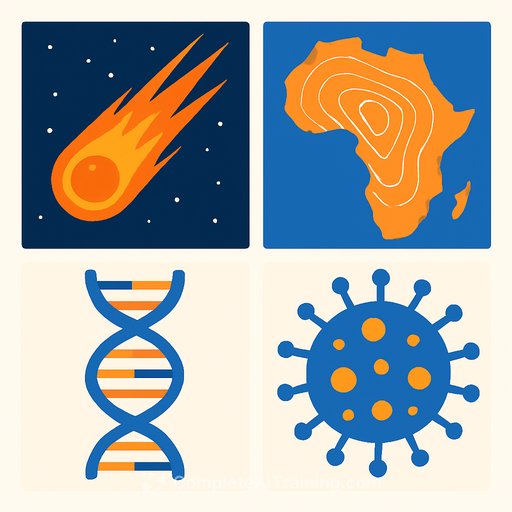Space science this week: Interstellar comet clues, a continent-scale gravity anomaly and AI-built viruses
This week delivered big signals across astronomy, geophysics and biosecurity. Here's what matters, why it matters and where to look next if you work in research.
Interstellar comet 3I/ATLAS: age, origin and unusual outgassing
Astronomers are narrowing down the origin of comet 3I/ATLAS, first spotted in late June. Early analyses suggest it formed in the far reaches of our galaxy and could be a relic from its earliest era - potentially billions of years older than the sun.
Observers watched the comet eject water at large heliocentric distance, "like a fire hose," well before significant solar heating. ESA redirected a Mars-orbiting spacecraft to capture the closest look yet at the coma, adding unique geometry and instrument coverage to ground-based campaigns.
- Why it matters: An ancient, interstellar body with active water outgassing challenges grain growth, thermal history and crust-cohesion assumptions in formation models.
- What to watch: Isotopic ratios and dust composition; pre-perihelion activity curves; any non-gravitational accelerations that refine the inbound trajectory and birthplace.
Elsewhere in the sky, radio astronomers produced the first imaging of two black holes in mutual orbit, new work hinted at possible dark matter stars, and JWST delivered eight strong-lens instances consistent with general relativity - a clean laboratory for mass mapping and high-z galaxy studies.
Strange gravity signal inside Earth
GRACE satellite records (2002-2017) reveal a 2007 gravity anomaly stretching the length of Africa. The signal lasted about two years and coincided with a geomagnetic jerk - both likely tied to a rapid redistribution of mass in the deep mantle near the core.
This points to dynamic processes we can't yet directly observe and raises questions about coupling between the core, mantle and magnetic field. Reanalysis with newer GRACE-FO and seismic datasets could localize the source region and bound plausible mechanisms.
- Dataset primer: See mission background and data access at NASA GRACE.
- Research angle: Joint inversions that combine gravity, geomagnetic secular variation and normal-mode constraints.
Who "discovered" America? Evidence across 23,000 years
Columbus was late. L'Anse aux Meadows in Newfoundland dates to ~1000 CE, confirming Viking presence. Indigenous peoples were present in the Americas long before that, with archaeological and genetic evidence pushing dates back to at least ~23,000 years ago. Polynesian seafaring contacts are also under active study.
- Takeaway: "Discovery" depends on perspective; the Western Hemisphere was populated and connected by long-distance voyagers far ahead of European arrivals.
AI designs new viruses - as bacteriophages
Researchers used AI to generate entirely new bacteriophages that infect bacteria, not humans. Safeguards prevented models from proposing agents for people, animals or plants, and the stated goal is to counter antibiotic-resistant infections.
The risk profile isn't zero. Studies continue to find holes in model guardrails, and regulation lags adoption. For teams building biological design tools, invest in red-teaming, dataset hygiene, compute governance and staged review before wet-lab execution.
- Skills update for R&D teams: See structured AI training options for safe-by-default workflows at Complete AI Training.
Also in science news this week
- Robotics got a boost from Google DeepMind's "thinking AI" - paired models that help machines reason about the physical world.
- Nobel Prize in chemistry awarded for "Harry Potter" materials work.
- A new Jurassic "sword dragon" species adds a useful datapoint to sauropod evolution debates.
- Fresh analysis of Shackleton's Endurance points to multiple structural shortcomings.
Science long read: The economics of extreme weather
Wildfires, tornadoes, heatwaves and floods are imposing steep economic costs - topping $100 billion by June 2025 alone. Projections show the trend worsening without stronger adaptation and mitigation. For policy and grant planning, tie climate attribution to asset-level risk and prioritize interventions with near-term loss avoidance.
Something for the weekend
- What we can learn from past pandemics, featuring perspectives from epidemiologist Michael Osterholm. [Book Excerpt]
- How institutional capacity at CDC is being eroded - and why it matters for real-time health outcomes. [Opinion]
- China's new emissions pledge: does it signal leadership on climate action? [Poll]
Science in motion: Fly a 1,000-mile Martian canyon
ESA released a new Mars Express animation that takes you over channels carved by ancient water, eroded islands and a giant impact crater. It's a quick way to calibrate your intuition for basin-scale geomorphology on a dry planet.
- Mission page: ESA Mars Express
Your membership also unlocks:






